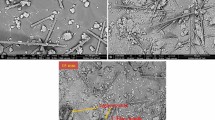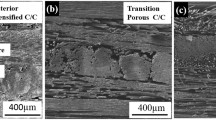Abstract
It is significant to compare the ablative and compressive mechanical behavior of different PICA-like materials in the engineering applications. The plasma wind tunnel ablation tests with high-entropy air and CO2 atmospheres, and compressive experiments in the ambient and 150°C, were conducted for three kinds of PICA-like materials (CF/PR-Si, CBCF/PR-SiOC and NQF/PR-Si composites). The traditional carbon/phenolic (C/PR) braided composites were also used for comparison. PICA-like materials have the better thermal insulation than traditional C/PR composite, especially for CBCF/PR-SiOC composite. The ablation behavior of CF/PR-Si and CBCF/PR-SiOC PICA-like materials in the CO2 atmosphere can produce a large amount of SiO2 in the form of coatings, oxide layers and skeletons on the ablated surface, which are greatly different from that in the air atmosphere. The compressive behavior of PICA-like material is greatly depended on the fiber fabrics, and exhibits the large discrete characteristics. The longer fiber in the PICA-like materials plays the role in maintaining the material integrity, while it may increase the thermal conductivity.
Similar content being viewed by others
References
Tran H, Johnson C, Rasky D, et al. Phenolic Impregnated Carbon Ablator (PICA) as Thermal Protection Systems for Discovery Missions: NASATM-110440. Washington, DC: NASA, 1997
Cheng H, Xue H, Hong C, et al. Preparation, mechanical, thermal and ablative properties of lightweight needled carbon fibre felt/phenolic resin aerogel composite with a bird’s nest structure. Compos Sci Tech, 2017, 140: 63–72
Wang C, Cheng H, Hong C, et al. Lightweight chopped carbon fibre reinforced silica-phenolic resin aerogel nanocomposite: Facile preparation, properties and application to thermal protection. Compos Part A, 2018, 112: 81–90
Du B, Hong C, Zhang X, et al. Preparation and mechanical behaviors of SiOC-modified carbon-bonded carbon fiber composite with in-situ growth of three-dimensional SiC nanowires. J Eur Ceramic Soc, 2018, 38: 2272–2278
Paglia L, Genova V, Marra F, et al. Manufacturing, thermochemical characterization and ablative performance evaluation of carbon-phenolic ablative material with nano-Al2O3 addition. Polym Degrad Stabil, 2019, 169: 108979
Sun Y, Hong C, Zhang X, et al. Preparation and properties of SiOC ceramic modified carbon fiber needled felt preform composites. Ceram Int, 2020, 46: 1743–1749
Duan L, Zhao X, Wang Y. Oxidation and ablation behaviors of carbon fiber/phenolic resin composites modified with borosilicate glass and polycarbosilane interface. J Alloys Compd, 2020, 827: 154277
Martin A, Boyd I, Cozmuta I, et al. Chemistry model for ablating carbon-phenolic material during atmospheric re-entry. In: 48th AIAA Aerospace Sciences Meeting Including the New Horizons Forum and Aerospace Exposition. Orlando, 2010. 2010–1175
Milos F, Chen Y K, Milos F, et al. Comprehensive model for multicomponent ablation thermochemistry. In: 35th Aerospace Sciences Meeting and Exhibit. Reno, 1997. 97–0141
Milos F S, Chen Y K, Gokcen T. Nonequilibrium ablation of phenolic impregnated carbon ablator. J Spacecraft Rockets, 2012, 49: 894–904
Driver D, MacLean M. Improved predictions of pica recession in arc jet shear tests. In: 49th AIAA Aerospace Sciences Meeting including the New Horizons Forum and Aerospace Exposition. Orlando, 2011. 2011–141
Shi S, Li L, Liang J, et al. Surface and volumetric ablation behaviors of SIFRP composites at high heating rates for thermal protection applications. Int J Heat Mass Transfer, 2016, 102: 1190–1198
Li W, Zhang J, Fang G D, et al. Evaluation of numerical ablation model for charring composites. Sci China Tech Sci, 2019, 62: 1322–1330
Shi S, Lei B, Li M, et al. Thermal decomposition behavior of a thermal protection coating composite with silicone rubber: Experiment and modeling. Prog Org Coat, 2020, 143: 105609
Lachaud J, Cozmuta I, Mansour N N, et al. Multiscale approach to ablation modeling of phenolic impregnated carbon ablators. J Spacecraft Rockets, 2010, 47: 910–921
Helber B, Chazot O, Magin T, et al. Space and time-resolved emission spectroscopy of carbon phenolic ablation in air and nitrogen plasmas. In: 44th AIAA Thermophysics Conference. San Diego, 2013. 2013–2770
Li G, Cheng M S, Li X K. Slicing-response model for ablation mass removal of polyformaldehyde irradiated by pulsed CO2 laser in vacuum. Sci China Tech Sci, 2015, 58: 158–162
Kobayashi Y, Sakai T, Okuyama K, et al. An experimental study on thermal response of low density carbon-phenolic ablators. In: 47th AIAA Aerospace Sciences Meeting Including The New Horizons Forum and Aerospace Exposition. Orlando, 2009. 2009–1587
Zhang B, Liu Y, Wang C H, et al. New discrimination method for ablative control mechanism in solid-propellant rocket nozzle. Sci China Tech Sci, 2010, 53: 2718–2724
Huang H M, Xu X L, Jiang G Q. Discrimination for ablative control mechanism in solid-propellant rocket nozzle. Sci China Ser E-Tech Sci, 2009, 52: 2911–2917
Parmenter K E, Shuman K, Milstein F, et al. Compressive response of lightweight ceramic ablators: Phenolic impregnated carbon ablator. J Spacecraft Rockets, 2001, 38: 231–236
Agrawal P, Chavez-Garcia J F, Pham J. Fracture in phenolic impregnated carbon ablator. J Spacecraft Rockets, 2013, 50: 735–741
Weng H, Martin A. Numerical investigation of geometric effects of stardust return capsule heat shield. In: 53rd AIAA Aerospace Sciences Meeting. Kissimmee, 2015. 2015–0211
Du B, Zhou S, Zhang X, et al. Preparation of a high spectral emissivity TaSi2-based hybrid coating on SiOC-modified carbon-bonded carbon fiber composite by a flash sintering method. Surf Coat Tech, 2018, 350: 146–153
Liu C, Han J, Zhang X, et al. Lightweight carbon-bonded carbon fiber composites prepared by pressure filtration technique. Carbon, 2013, 59: 551–554
Author information
Authors and Affiliations
Corresponding author
Additional information
This work was supported by the National Natural Science Foundation of China (Grant Nos. 11672089, 11732002 & 11902333).
Rights and permissions
About this article
Cite this article
Zhang, J., Fang, G., Yang, L. et al. Comparison of ablative and compressive mechanical behavior of several PICA-like ablative materials. Sci. China Technol. Sci. 63, 1478–1486 (2020). https://doi.org/10.1007/s11431-020-1618-2
Received:
Accepted:
Published:
Issue Date:
DOI: https://doi.org/10.1007/s11431-020-1618-2




